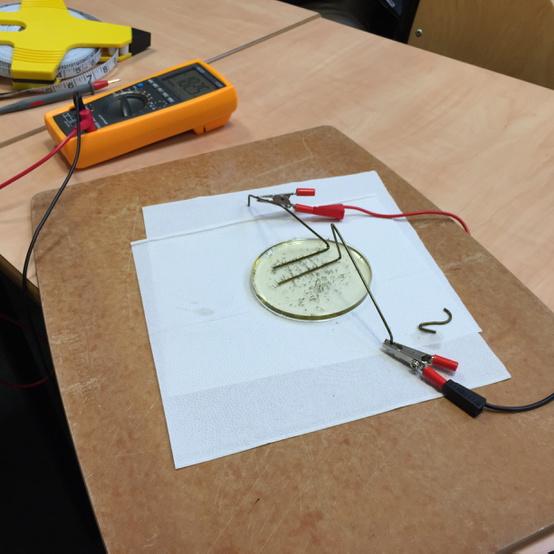Several years ago I shared Wayne Mullins' demonstration of electric fields and potentials. He used two metal PASCO masses placed parallel to one another in water to produce a uniform electric field in the water. The electrodes were connected to ~25 VAC. The linear variation of potential with position between the plates can be demonstrated with a voltmeter; a couple of fingers spread in the water (done carefully -- read the post!) can show viscerally what a potential difference really means.
Today in my visit to TASIS American School in London, blog reader Scott Dudley showed me and his classes a similar demonstration. He connected 2000 VDC to two small wires placed in a pool of corn oil. A sprinkling of some grass seed between the wires showed these long particles lining up with the electric field lines, as you can see in the picture. This demonstration provoked three thoughts from me.
(1) Why would the particles align with the electric field rather than along the equipotential lines? Teacher Dallas Turner once suggested using goldfish in water between the electrodes to show the equipotentials. The goldfish will align perpendicular to the electric field so that no current runs through their bodies due to a potential difference. So what makes grass seeds different? I expect that the seeds are slightly polarized... then they experience a torque because they're dipoles in a uniform electric field. That torque aligns them with the field: the positive end is forces as close as possible to the negative plate, and vice-versa. (Right?)
(2) I suggested that Scott use a voltmeter to map the equipotential lines, as I do in Wayne's demo. So Scott gamely stuck the probe in the oil... and nothing. No reading. Why not? Because, as Scott immediately pointed out to me, the meter produces a small (few milliamp) test current in order to measure a voltage. The oil is a strong insulator, thus not allowing the meter to make the measurement. The demonstration works fine when I do it in tap water, because tap water is quite conductive. Of course, Greg... that's why I need water in the first place rather than just the air in between the two electrodes. And that's why the "field mapping" lab exercise is generally done with conducting paper.
(3) The AP Physics 2 exam does not deal with traditional field lines. Instead, field mapping is done using "vector fields" in which a multitude of arrows indicate the magnitude and direction of the electric (or magnetic or gravitational) field at various positions. The grass seed can help develop an understanding of the vector field representation. Each individual grass seed is pointing in the correct direction; now, draw each seed, but draw it bigger or smaller depending on the strength of the field at that position. Nice.
Thank you to Scott for hosting me at his school. I met a number of clearly excellent teachers; I wish I could have spent more time with everyone there. Perhaps I can convince my school to send me to London a second time... :-)
GCJ




Subtle difference...
ReplyDeleteDMMs produce a small current to measure resistance. When measuring voltage, each end of the probe connects to opposite ends of a large resistance. The 2 probes create that same potential difference across that resistance and current can be measured. The measured current with the known (and very large) resisrancw within the meter alliw the dmm to calc voltage.
Have a good one.
I thought the same thing as Mr. Lulai. I do a similar lab but you have given me some ideas about how to pose questions for the students. thanks.
ReplyDeleteI thought the same thing as Mr. Lulai. I do a similar lab but you have given me some ideas about how to pose questions for the students. thanks.
ReplyDeleteMr. Lulai's explanation is better, but a DMM really does measure voltage, not current. The resistance is an undesired parasitic that is difficult to avoid in cheap meters. Expensive DMMs use an amplifier with a high impedance input (> 10GΩ for the high-impedance DC setting of the Agilent 34401 meter) to reduce this parasitic. Some AC meters for electricians doing house wiring deliberately use a fairly low impedance, so as not pick up capacitively coupled signals, but only ones from direct connection to low-impedance wiring.
ReplyDeleteA cheap DMM like the one shown is likely to have about 1MΩ input impedance, which is much less than oil's resistance.
I would have thought that the meter presents a constant large resistance to to circuit and then measures the current and calculates the voltage with the current and resistance.
ReplyDelete